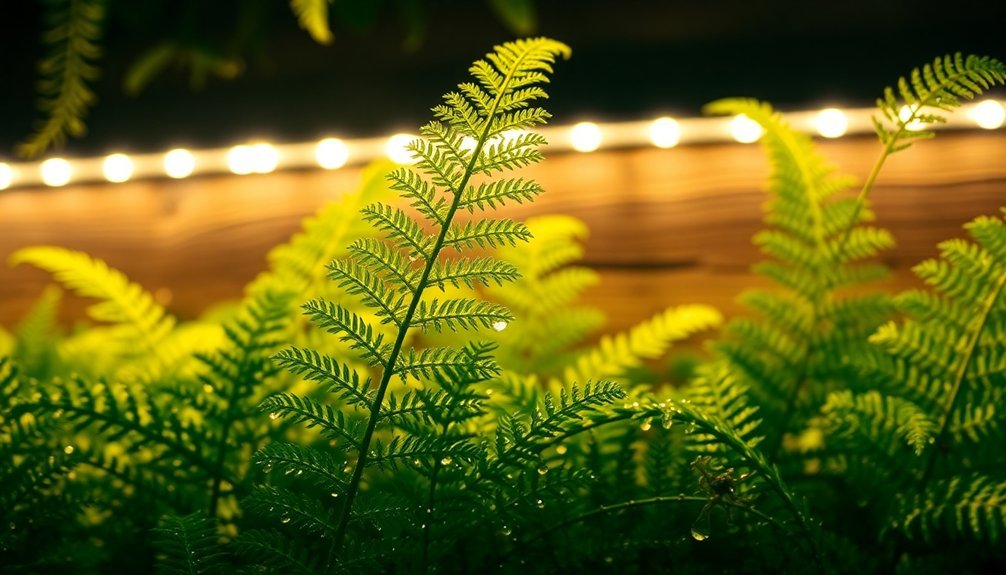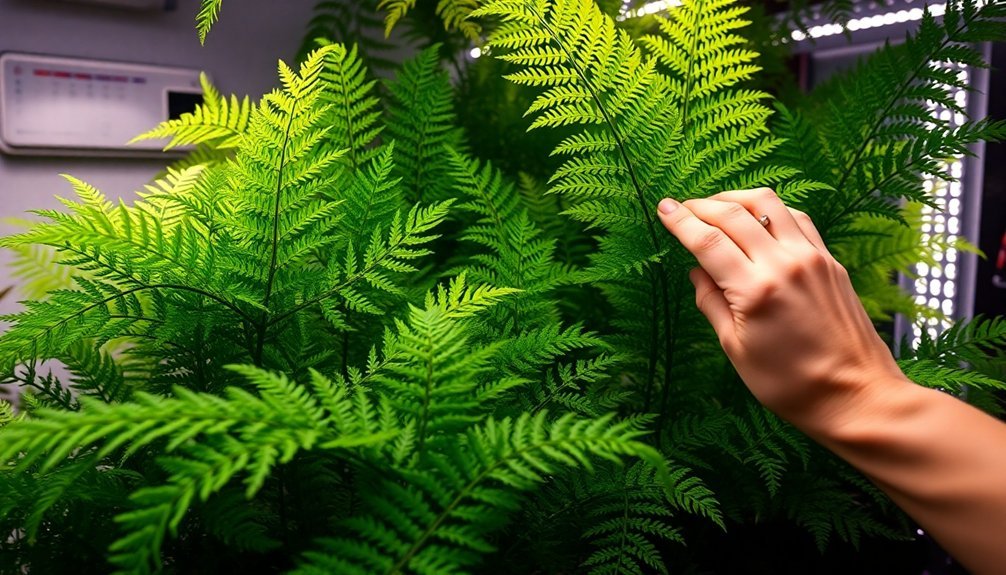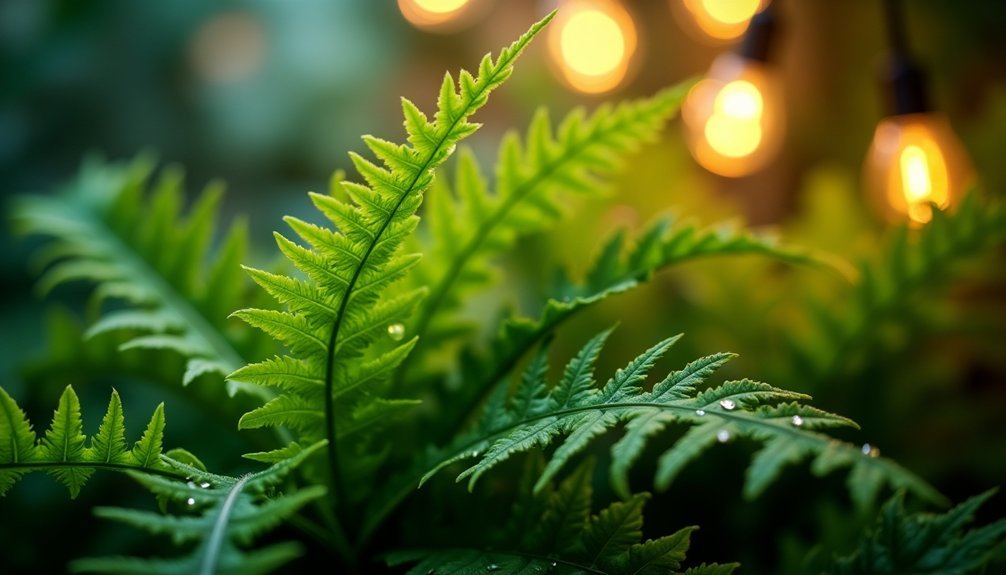The best LED grow lights for your ferns combine full-spectrum illumination with adjustable positioning. Consider the SPIDER FARMER SF-1000, ideal for small collections, or the MARS HYDRO TS 1000W for larger setups. The VIPARSPECTRA P1000 offers excellent coverage, while the MAXSISUN PB 1000 delivers precise light control. Don't overlook the budget-friendly BLOOMSPECT 1000W, which still provides essential blue and red wavelengths. Understanding proper setup and monitoring will maximize your ferns' growth potential.
Understanding Your Fern's Natural Light Requirements

When it comes to selecting LED grow lights for your ferns, understanding their natural light requirements is essential for success. Most ferns thrive in indirect light rather than full sun, with light intensity needs varying by species.
While Boston ferns can handle brighter light levels, maidenhair ferns prefer shadier conditions.
Your plants need consistent light exposure of 12 to 14 hours daily for ideal light conditions. When using LED grow lights, you'll want to monitor energy usage while ensuring proper light levels for your specific fern variety.
Watch for signs of insufficient light, such as yellowing leaves or leggy growth – these indicate you'll need to adjust your lighting setup. By matching your LED settings to your fern's natural preferences, you'll create the perfect environment for healthy growth.
Top LED Light Features for Healthy Fern Growth
Now that you understand your fern's light needs, selecting the right LED features will make a significant difference in your plant's growth.
Full-spectrum LED lights deliver essential wavelengths for photosynthesis, promoting healthy fern growth when positioned 12 to 24 inches above your plants.
Full-spectrum LEDs provide the perfect light recipe for ferns, encouraging robust growth when properly positioned above your plants.
Look for LED fixtures with a Color Rendering Index above 90, as this guarantees accurate color representation and ideal growing conditions.
You'll want adjustable light intensity features to match your specific fern's light preferences and prevent issues like stretched-out fronds. Set your lights to run 12 to 14 hours daily for proper light exposure.
Don't forget about air circulation around your LED setup to prevent overheating.
Good airflow protects both your lights' performance and your fern's delicate fronds, guaranteeing long-term success with your indoor garden.
Positioning and Setup Tips for LED Fern Lighting

Proper positioning of your LED grow lights makes the difference between thriving and struggling ferns. Your indoor plant needs consistent lighting and precise setup to flourish. Position your light source 12-24 inches above the plants and use reflectors to guarantee even light distribution across all fronds.
- Set up a timer to provide 12-14 hours of daily illumination, meeting your fern's light requirements while maintaining natural growth cycles.
- Install humidity trays beneath your plants and monitor moisture levels to offset the drying effects of LED lights.
- Place reflectors strategically around your setup to maximize coverage and prevent shadowy spots.
Remember to rotate your ferns regularly under the LED lights to promote balanced growth. This simple adjustment helps prevent leggy development and guarantees all parts of your plant receive uniform exposure.
Essential Light Spectrum Components for Ferns
Understanding light spectrum requirements is crucial for successful indoor fern cultivation. Your ferns need a full spectrum that mimics natural sunlight, with specific emphasis on blue and red wavelengths to support maximum photosynthesis and plant growth.
Full-spectrum lighting that mimics natural sunlight is essential for indoor ferns, focusing on blue and red wavelengths for optimal growth.
When choosing LED grow lights for your ferns, look for fixtures that provide both blue light (around 450nm) and red light (around 660nm) in a 1:2 ratio. Blue light helps maintain compact foliage and supports vegetative growth, while red light enhances overall fern health.
The right combination of these wavelengths will guarantee your ferns develop healthy, vibrant fronds.
Monitor your light intensity carefully, keeping it between 100 to 1,500 lux depending on your fern species. Indoor grow lights with adjustable settings can help you maintain these ideal conditions throughout your fern's growing cycle.
Monitoring and Adjusting LED Intensity for Optimal Results

Successfully growing ferns under LED lights requires careful monitoring and adjustment of light intensity throughout their growth cycle.
You'll need to regularly monitor lux measurements to maintain ideal growth, targeting 12,000 to 20,000 lux depending on your fern species. Using a light meter helps guarantee you're providing the right intensity while preventing leaf damage.
Key steps for monitoring LED intensity:
- Position your LED fixtures 12-24 inches above your ferns, adjusting height as needed to maintain proper light levels.
- Check light intensity daily with a meter, watching for signs of inadequate light like yellowing leaves.
- Gradually increase LED brightness when introducing new lights, allowing your ferns to acclimate while monitoring growth patterns.
Make adjustments based on your ferns' responses, ensuring they receive consistent, appropriate light for healthy development.
Frequently Asked Questions
What Light Is Best for Ferns?
You'll want bright, indirect light for your ferns. If you're growing them indoors, use full-spectrum LED grow lights positioned 12-24 inches above them for 12-14 hours daily to guarantee healthy growth.
What Color LED Light Helps Plants Grow?
You'll get the best plant growth using LED lights that combine blue (450nm) and red (660nm) wavelengths. These colors are essential for photosynthesis, while full-spectrum lights with added white provide balanced development.
Can Ferns Survive With Artificial Light?
Yes, your ferns can survive and thrive with artificial light. You'll need LED or fluorescent grow lights positioned 12-24 inches above them, providing 12-14 hours of daily light at 100-1,500 lux intensity.
What's the Best LED Light for Plants?
You'll get the best results with full-spectrum LED grow lights that offer adjustable intensity and coverage. Look for brands like Spider Farmer, Mars Hydro, or VIPARSPECTRA, which provide excellent light distribution for indoor plants.
In Summary
With these LED lighting solutions, you're now equipped to give your ferns the perfect growing environment they need. Remember to monitor your plants' response to the new lighting setup and adjust accordingly. Don't forget to maintain proper distance, timing, and intensity levels. When you've found the right balance, you'll see your ferns thrive with lush, vibrant growth year-round.





Leave a Reply